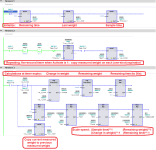drbitboy
Lifetime Supporting Member
@walkerist:
many here could write the code, and have done so in the past, using any of a number of models/algorithms/approaches, but you are a student, so we are going to wait to see what you code first.
However, before you write even one line of code/ladder, show us your model. That's the hard part; the coding is easy.
E.g. forget all my stuff, just use the model where you predict an in-flight/tail/spill value INFLIGHT, that will fall into the bag after the PLC gets a measurement equal to or greater than [TARGET_WEIGHT - INFLIGHT] on some scan and stops the motor. Write that code, but make INFLIGHT a variable e.g. loaded from an HMI.
The problem is that the in-flight value will probably vary with the fill rate, even if the motor speed is a constant 100%. Write some code to vary a maximum MAX_INFLIGHT value* for variable fill rates, and then use write code to use that variable in-flight value to have the PLC stop the motor using the modified fill rate.
Note that now you have to
many here could write the code, and have done so in the past, using any of a number of models/algorithms/approaches, but you are a student, so we are going to wait to see what you code first.
However, before you write even one line of code/ladder, show us your model. That's the hard part; the coding is easy.
E.g. forget all my stuff, just use the model where you predict an in-flight/tail/spill value INFLIGHT, that will fall into the bag after the PLC gets a measurement equal to or greater than [TARGET_WEIGHT - INFLIGHT] on some scan and stops the motor. Write that code, but make INFLIGHT a variable e.g. loaded from an HMI.
The problem is that the in-flight value will probably vary with the fill rate, even if the motor speed is a constant 100%. Write some code to vary a maximum MAX_INFLIGHT value* for variable fill rates, and then use write code to use that variable in-flight value to have the PLC stop the motor using the modified fill rate.
Note that now you have to
- write code to measure the fill rate continuously,
- come up with a model to calculate and in-flight value based on MAX_INFLIGHT and the measured fill rate,
- write code to implement that model.
- 100% motor speed,
- washer not starvation-feeding the conveyor,
- 0.5g/ms (10kg/20s = 10000g/20000ms) fill rate.






